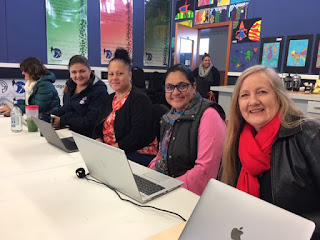Great PD!
Diverse Learners
What I have taken from it:
Anger is another
presentation of anxiety. Fight, flight, freeze
(Images borrowed from NZ Anxiety website)
How can we as teachers help?
Explicit coaching
around emotions for kids that flare up out of nowhere. Talking through
physical aggression. Listen to your body. How do you feel? How is your heart
feeling? What do you feel like doing right now? What else could you do?
Prevention is
better than reaction. Know your learners well enough to know how much they can
cope with. If they can work for ten minutes, stop at 8 minutes.
Parents:
Parents of diverse students are often tired and overloaded as they have been dealing with their children for a long time. They don't need teachers telling them how bad their children are. Communication and building relationships with parents of diverse learners are extremely important. Showering them with love. Then they will feel supported - and will support us.
To get
accelerations for diverse students, we need to use a holistic approach, not
just learning. Include teaching about emotions, attitude, active participation, self-esteem, taking risks, self-managing.
Teacher agency is
okay!! Recognizing, today is not the day to teach this specific activity that I planned. Press pause and revisit at another time. If that means they need time outside to play ball before they come back
to learn, that is okay. Make the call.
Reporting for
diverse learners – could include attitude, confidence etc. Not necessarily
tests…
Learner Action
Plan
Tap into their
strengths; e.g. possibly let them take the lead in something. If they like
science, use science to get them to do the writing.
In the classroom:
Set things up
that is available for everybody, but have a rule that when Student Anxiety needs a
quiet space, they might have to stand up and give him space. Talk to your
class.
Explaining that we
are all different, some like sport, others not, etc, etc.
Setting a culture
of caring, acceptance, and understanding.
Diverse Students:
Dyslexia can
learn to read, write and study efficiently when they use methods geared to
their unique learning style.
ASD has lots of
things going for them. Topic interests, exceptional memory for facts and
figures, a high degree of accuracy, attention to detail, follow instructions and
rules very accurately, creative arts
Honest, loyal,
sense of humour, hobbies
Universal design
for learning (UDL) a good approach for diverse learners.
Engagement,
representation, action and expression.
Think of visually
busy and quiet spaces.
Dyslexia –
recognising letters on the keypad is a challenge. Might be better to write than
type.
Myths: that they
read backward or spelling being jumbled.
It’s about trouble remembering letters symbols
for sounds and letter patterns in words.
Explicit phonics
teaching makes it better.
They don’t have a lower level of intelligence.
Tips for
dyslexia:
1. Specific and
explicit phonics instruction
2. Build their vocab
and comprehension through audiobooks
3. Front-loading
before group learning- do not let a dyslexia student do Guided reading before
they have listened to the MP3, read it with somebody beforehand or read the
book before the time. It’s too hard. Don’t let them decode for the first time
in a group and expect them to read. Too stressful.
4. Move from the
known to unknown. Working from at to cat or like to bike etc
5. Avoid passive
phrases and sarcasm or double meanings. They don’t understand.
6. Praise is very important. Praise them for asking questions.
7. Find ways to
provide increased processing e.g. deliberately pausing after you ask a question
8. Check-in with
students soon after they commence work to ensure they’ve got it right – if they
haven’t, ensure you put them on the right track
If testing:
- Digital Clock
- Short breaks in
the middle, tests in two parts
- Multisensory
approaches work best
- Quick drawing to
illustrate concepts
- Use pictures,
diagrams and charts and use coloured highlighters for emphasis
- Use real objects
as props
When anxiety is
high, reduce the demands, when anxiety is low, increase the demands.
Sensory pathways
see 3D stickers of a bridge can be good in a corridor to give anxious students a chance to move when anxiety is high.
Weatbags on their
shoulders could ground them.
Do heavy work for diverse kids before expecting them to sit down and learn e.g. wheelbarrow - picking up leaves or digging in the garden, that cannot settle to sit down and learn.
Speld – for
dyslexia diagnosis
Start with RTLB
to do a screen







